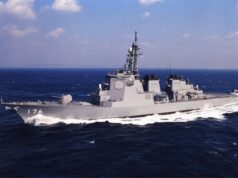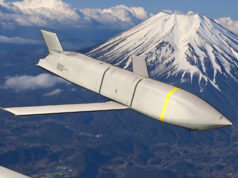China’s second aircraft carrier might conduct its first sea trials in February, regional newspapers are reporting.
China launched its second aircraft carrier in April 2017 after the Liaoning, a refitted Soviet Union-made carrier that went into commission in 2012. China’s second aircraft carrier is the country’s first domestically made carrier.
“China’s first homemade aircraft carrier might conduct its sea trials around Spring Festival in mid-February” Li Jie, a Beijing-based naval expert, told the local Global Times on Sunday.
The carrier’s design is based on the Kuznetsov class, as China’s first carrier, Liaoning, was constructed from an incomplete Kuznetsov class vessel and the 001A is a slightly refined version of Liaoning.
It is slightly modified and upgraded compared to Liaoning, with improved radar and increased storage capacity for ammunition and fuel, allowing it to carry more aircraft than Liaoning (estimated to be between 30 and 40 jets and helicopters).
The vessel reportedly measures about 315 metres (1,033 ft) long, with a displacement of about 55,000 tonnes







We’ve been discovering how long it takes to rebuild a capability but it’s very interesting to see here how long it takes to build a capability from scratch and how methodical China is being in doing it via this one-step-at-a-time approach. It’s not as if China is short of ambition or personnel and is willing to spend heavily on projects (space program, building out its airport infrastructure etc) and yet after the first second hand Russian carrier it didn’t jump straight into building a super carrier but stayed safe with a design derived from the first carrier.
I suppose it shows how complicated carrier design is (and is another reminder of how much respect our carrier design teams deserve) but given China’s global ambitions surely at some point they will start building US-style super carriers and if they don’t then it would make me wonder whether Chinese military strategists had decided that carriers were too vulnerable to build in the too-expensive-to-lose super carrier category.
What i find more interesting is that nobody is talking about India.
Yes, China is creating a good surface fleet, and learning how to make carriers is a start. But the only regional power to challenge China is India, and they too are making a carrier.
It’s a good thing our ally is too. We cannot keep asking the US to protect shipping lanes and international trade routes, so seeing India come to the table, and Japan possibly retrofitting an LHD or LHP to accomodate F35b is good to balance out the power in the region, and spread the responsibility around Nato and friendly forces.
China may go to a super carrier, but a Ford/Nimitz is something else all together.
Thats twice the displacement of what they have now. And America have 10 of them already.
I cant see China pushing too hard for such massive massive assets as the US do. But hey, could be wrong.
india has a genuine plan for naval expansion, and is sticking to it its also disconcerting to see than the navy of japan is now bigger than the u.k and france combined. its not always about money, ambition and a decent game plan can make ideals go further.
They have another carrier under construction the (Type 02). Supposed to have begun construction last November. They delayed construction on it because according to them it will have EMALS and they hadn’t figured out how to power it yet. The Type 2 is supposed to be 85,000 tons so about the size (just over 2300 tons) than the old John F. Kennedy. Like Kennedy it’s conventionaly powered. Their plans are to follow it with the planned Type 3 which is a nuke and the size of a Nimitz 100,000 tons.
Seems their build plans are to give the yards experience with smaller non-nuclear carriers. Before they attempt the more ambitious nuclear powered super carriers. That and to give their Navy time to build up experience with naval aviation and blue water experience with the escorts they also have under construction.
and its got aircraft!
I do think this is a good looking ship and the ski jump bow puts the QEC’s to shame (sorry – but ours looks like a bolt on).
China probably has the plans for the Ford class and has decided too big…
The QE is specifically designed for VTOL.
The Chinese is specifically designed for fixed wing. So it has to have a far longer ski ramp. The QE doesnt.
i’m still of the opinion the ramps should be removed on the u.k carriers and a emals fitted giving the chance to operate sea gripen and rafales.
The ski jump only puts ours to shame aesthetically. As I understand it the profile of our ski jump was very carefully designed to be optimal for the F-35B. I wonder whether the Chinese ski jump has been optimised quite so precisely for the primary aircraft it is designed for.
I suppose that is one advantage of the QEC being a carrier that only has a single class of fixed wing aircraft on board. It does mean it can be optimised for that single class whereas with multiple classes, unless they share identical requirements wrt the ski jump, the profile could only be optimised for one of those aircraft at the expense of others or, I suspect more likely, be a compromise between the multiple types that it needs to launch.
I do agree though, nice looking ship.
QE ramp only odd from head on angle and everyone has their better side 😉
#QELove
Does a bolt-on ramp mean you can convert to cats and traps later at a lower cost than if you had to rebuild the whole flight deck?
It was supposed to be until BAe sabotaged it to ensure it wouldn’t be.
Thought that was Cameron who buggered it up. Said costs of electro cats were too expensive, so swapped design and planes, which clearly was the most economical way for a simpleton. Which he is.
i googled queen elizabeth carrier without ski ramp and under images there is an interesting picture of what i see as a better looking configuration
With that ski ramp I expect to see her planing into a strong wind.
Olly
I nearly didn’t post my original comment – due to the fact that I believe this is the logic behind the QEC ramp, as I think the long term plan was to move to EMALS at a mid life point.
However, given my understanding of the benefits of a ski jump – they should be integral to the design of all carriers.
As Julian says ours have a very precise angle – that has been worked upon since we first introduced them, even with a catapult system the ability to get air under the wings is still important, so I think the ski jump will stay no matter what.
Ian – I also love the QEC….
Many thanks 🙂
The Russian/Chinese/Indian style of bow is all very well, but ties the ships to STOBAR operation, with more restrictions than the RN STOVL design with regard to future upgrades. Just as important, the entire area to starboard of the ramp on QE is available as a deck park, making for much greater utility during flight operations. The RN design may be utilitarian, but is designed for purpose, not aesthetics – this is after all a warship!
“The RN design may be utilitarian, but is designed for purpose, not aesthetics – this is after all a warship!“
LOL. Otherwise where would it end? …
“We need some accent colours to break up all that drab grey”
“The top sides need to make use of different textures to create more visual interest”
“We’ve positioned mirrors at certain points on deck to create a greater feeling of space”
“Extensive use has been made of coloured mood lighting, blue to create a sense of calm around the on-deck preparation areas with the CIWS bathed in a dramatic red to create a sense of menace.”
Very good!
Never mind the bow…check out the size of the crane to her left!
Our family business have this year stopped importing from China they can’t yet even make a decent screw or anything else believe me this Carrier will be rubbish in the real world ..
or are you just importing the very cheapest you can find. I’ve got a Chinese-built MG3. Very nice, reliable and feels solid.
The Chinese do not have to have a capability to surpass the USN carrier fleet they only need a local superiority so a fleet of 5-6 carriers will be enough to challenge US navy power projection into the western Pacific and throughout Asia.
Even the US cannot afford to re-equip it’s carrier battle groups with the massively expensive Ford class. They cost over £13 billion each.
The US would be much better advised ordering an EMLs equipped QE class carrier fleet. For the price of 4 Ford class they could have 12 new 70,000 ton carriers with lean Manning 1600 crew including aircrew Vs over 5000 for Ford class. The QE class is a triumph of modern design and technology and I have no doubt those ships will save our bacon Inthe future. Just so long as we have a capable royal navy to protect them.
There’s the rub. Escorts.